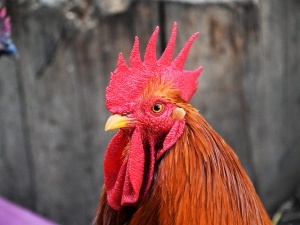
Apart from an increase in size and feather color, chickens will more or less look the same as they age. The slightest change in the behavior or appearance of your chicken can be a sign that something has changed in your bird.
If your bird suddenly develops sores on its comb you’d be right to be worried. This article looks into why this happens
Table of Contents
Sores on chicken’s comb:
Sores developing on your chicken’s comb can be a particularly worrying issue, this usually means that the bird is quite ill. If your bird has sores on its comb then the bird likely has:
Fowl pox
Fowl pox is a viral infection that affects a variety of birds, chickens included.
The illness can be transferred via scabs that fall off of sick chickens which are picked up and eaten by other birds.
The scabs can also turn into powder which may be inhaled by other birds. This disease can also be caught by chickens via contaminated equipment as well as from bites from insects.
A chicken that has fowlpox will develop sores on its comb, and/or on the other featherless parts of its body like the wattles, face, and legs. These sores will then turn yellow, then turn black as they turn into scabs.
What to do:
There is no treatment for fowl pox, the bird will usually recover on its own in 2-4 weeks. The best thing you can do for a recovering bird is to give the bird supportive care as it recovers.
Start off by isolating your bird, this will keep it from spreading the disease to its other flock members.
Sanitize your bird’s waterers on a daily basis by adding ¼ teaspoons of oxine per one gallon of your bird’s drinking water. Cleaning the coop is also a must, do this using oxine at least once a month.
You can treat the bird’s scabs by dabbing iodine directly onto the scabs using a q-tip. This will help the scabs heal better and fall off quicker.
If your bird develops a secondary infection, then your vet will likely prescribe tetracycline antibiotics to treat the secondary infection.
Favus (ringworm):
Ringworm not only affects mammals and humans, but it can also affect chickens as well. This skin condition is caused by a group of zoophilic fungi called dermatophytes.
One particular fungus called the Microsporum gallinae, also known as Lophophyton gallinae, is a common fungus that causes ringworm in chickens.
Healthy birds can catch this illness if they touch a sick bird.
If your bird has this ailment then the sores, or lesions, on your bird’s skin are what you will see first. The sores can develop on the bird’s comb, but they can also develop on the bird’s lower legs and wattle as well.
The sores will then develop into white spots, your bird will look like it was sprinkled with flour at this point. Feather loss can also develop after this as well as thick, crusty skin around the bird’s head.
What to do:
Start off by isolating the sick bird, this will keep it from infecting its flock members. You’d also need to disinfect the area to keep the other birds from becoming infected.
Treat your bird by applying an antifungal medication directly to the affected areas of the bird’s skin. Miconazole, or miconazole nitrate 2%, should work on the sores.
Depending on where you are, this treatment may be packaged in the form of a cream, ointment, or a powder, any of these will work to treat your bird.
You can also mix formaldehyde and vaseline to create an ointment to treat the bird’s sores. Rub this ointment on your bird’s sores as a treatment.
If your bird has a mild cause of favus then the ailment can be treated and will improve at home. If your bird has a severe case of favus then you may need to take your bird to a vet.
If you enjoyed this article then you may also be interested in other bird related articles. Here are some articles that you may be interested in: Black Scabs On Chicken Comb, Lump On Chicken’s Beak, Wart On Chicken Beak

